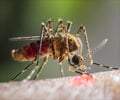
‘As the Zika virus rearranges the endoplasmic reticulum and cytoskeletal architecture of host cells to replicate, targeting cytoskeleton dynamics may suppress Zika replication.’
Tweet it Now
In Cell Reports, researchers in Germany show how
the African and Asian strains of Zika rearrange the endoplasmic
reticulum and cytoskeletal architecture of host cells so that they can
build factories where they make daughter viruses. The study reveals that
targeting cytoskeleton dynamics could be a previously unexplored
strategy to suppress Zika replication.Senior author Ralf Bartenschlager, a virologist at Heidelberg University, said, "Zika virus infections cause a drastic perturbation of the cytoskeletal network, re-organizing both intermediate filaments and microtubules into a cage-like structure that surrounds the replication machinery."
His group, led by first author and Heidelberg postdoctoral fellow Mirko Cortese, also found that Zika and dengue, both flaviviruses, use similar strategies to infect host cells. Once inside of a cell, viral particles latch onto the rough endoplasmic reticulum - the ribosome-rich membranes outside the nucleus where RNA is translated into proteins. The viruses then remodel the endoplasmic reticulum to form a protective cage with small holes where RNA and newly made viral particles can travel in or out.
The difference with Zika is that it has unique ways of rearranging structures within the cell. For example, there are an abundance of microtubules - proteins that build the cellular cytoskeleton - surrounding its protective cage. There were also slight variations between how Zika establishes itself in human liver cells versus neural stem cells, where it is more physiologically relevant. This suggests there are yet-unknown cell-type-specific factors that affect how the virus replicates.
"The cytoskeleton has a crucial role in neurogenesis," Cortese says. "Thus, it is tempting to speculate that the alterations induced by Zika virus on the host cytoskeleton might be connected to the underlying physio-pathological mechanisms that link congenital Zika virus infections to microcephaly and neurodegenerative disorders."
Advertisement
"Having identified a link between cytoskeleton dynamics and Zika virus replication, together with the plethora of available cytoskeleton-targeting compounds, might contribute to gain mechanistic insight into the ZIKV replication cycle and identify new avenues for treatment," Bartenschlager says.
Advertisement











